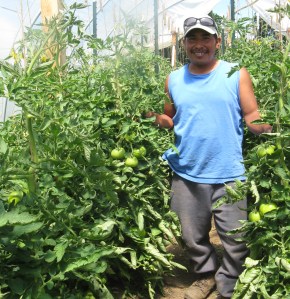At Gathering Together Farm, in Philomath, Ore., owners Sally Brewer and John Eveland sit down with all their employees three times a week for an all-farm lunch. At the height of the growing season, Gathering Together Farm employs as many as 100 people, so Brewer and Eveland bring in employees on those days especially to cook. It’s no small expense, but it’s a way to ensure that the field crew gets face time with the irrigation crew, the office employees, and the farmers market crew.
“It’s a huge meal, and it’s part of the benefits package,” says Rose Mahoney, who helps manage the farm. “It really has a family feeling.”
The organic farm offers a community-supported agriculture (CSA) box, offers their produce at eight different farmers markets around Oregon, and they are known, says Mahoney, as a farm that treats its workers well. Brewer and Eveland have long prided themselves on respectful communication with all their employees; they also make extra produce available to take home — no small deal considering the fact that farmworkers can, ironically, rarely afford healthy food.
All this said, the farm’s owners hadn’t put too much thought into whether their customers thought about labor — after all, they figured, who worries about worker rights when buying from small, organic farms?
Then last year Gathering Together was approached by its distributor, Organically Grown Company, and encouraged to apply for the Food Justice Certification. The label, which is still nearly unknown in the marketplace, is a product of the larger “domestic fair trade” movement, and is similar to the Fair Trade label for international food production. Because certification is expensive, and farms like Growing Together run on a tight margin, it helped that the distributor offered to pay for the certification.
Now, a year later, Growing Together and a second Oregon operation, Spring Hill Farm, have joined the small ranks of Food Justice Certified farms. How small is small? Well, according to Elizabeth Henderson of the Agricultural Justice Project (AJP) — the coalition of four NGOs behind the label — there are now 70 farms certified in Canada and eight in the U.S.
Based on a rigorous set of standards developed over four years, and a lengthy process that includes confidential interviews with each farm’s workers, the Food Justice Certification label, says Henderson, is an effort to “reward the people who have the best practices.”
Why would it matter that small handful of farms producing a very small percentage of the nation’s overall food supply would carry the Food Justice Certified label?
Well, for starters, it creates a point of comparison for the rest of the food system. We live in a time when consumers don’t have to dig too hard to find examples of really terrible farm labor practices. From documented cases of slavery and other human rights abuses in Florida’s tomato fields, to workers dying from heat exhaustion on California farms, and new data about the plight of women on farms and people of color in the food system at large, the national picture is pretty grim.
And while the assumption that organic farms are generally better to their workers might be borne out anecdotally, actual organic certification includes one word about the way farmworkers are treated. And to be fair, food production in this country has relied on a cheap (often undocumented) labor force to keep food prices low for so long that even farmers who want to pay their workers well are rarely in a position to do so.
It might sound obvious, but the people you see selling produce at the farmers markets are not — in the vast majority of cases — the same ones who plant, harvest, weed, irrigate, and pack that food into boxes. In other words, even most farmworkers who are treated well are still invisible to eaters. So any small, perhaps symbolic-seeming steps towards engaging eaters in the larger discussion about their rights has to be worthwhile.

The Certified Food Justice label was awarded to two Oregon farms near the end of 2011.
Codifying respect
For both Oregon farms, becoming Food Justice Certified has been largely about getting organized and documenting their relationships with workers in a new way.
Spring Hill Farm’s Jamie Kitzrow was pleased to see that his farm didn’t have a lot to change to be recognized as a just workplace. “That felt great,” he says.
“It did force us to put more effort into explaining the rights of workers to those employed with us, set up a clearer program of job descriptions, a pay scale based on experience, merit, and seniority, conduct annual evaluations, and have a pre-season employment agreement in which expectations are clearly laid out and agreed upon,” he wrote in a prepared statement about the certification.
The biggest hurdle? Like organic certification, Food Justice Certification requires a lot of paperwork, more record keeping, logs, signage, etc.
Rose Mahoney of Gathering Together had similar observations. While the farm already had official job descriptions and a review system in place, getting certified meant adopting new language and making more of what they were doing just a little more official (like getting workers to sign off on their annual reviews, for instance). Like most certification processes, it was time-consuming and costly for the farm, she says, but “we were happy to see that adopting the standard was so straightforward for us; it validated what we already believed we were as a farm.”
For Kitzrow, it’s been more than worth it. Although Spring Hill Farm remains relatively small, it has definitely grown quite a bit in recent years, making it impossible for the farmer to know all his customers personally — so certification serves as a way to put his values right up front. “It felt good to be a part of something that helps keep a focus on and reminds all of us of the importance of agricultural working conditions here at home,” he says.
Paulo Maritnez has been on Kitzrow’ farm crew since 1999. Before coming to Spring Hill he had worked for other farms but never for longer than a few days. “I like how the farm has worked with these programs,” he told Grist recently. “We’ve changed a lot in the way we work, in the sense that the boss has helped with everything. He’s told us how to do things. He’s learning Spanish.” While, Martinez adds, he thinks the farm still has room to improve, he feels respected as a long-term employee, and has agreed to help train the less-experienced workers. He’s also learned some English. “For us,” he says, “this certification means a lot. It’s worth it.”
Potential growth
As more and more eaters begin to care about how, where, and under what circumstances their food was produced, it’s likely that domestic fair trade will pick up speed and Food Justice Certification will become a household name. For one, AJP has trained a number of farmworker organizations and organic certifiers in Oregon, California, and New York to certify farms’ labor practices as well. Swanton Berry Farm, organic strawberry pioneers known for their work with the United Farm Workers, is also rumored to be in the process of becoming the first California farm to don the Food Justice Certification label.
Henderson, who was involved in certifying the Oregon operations, says, “I very moved by what I saw going on both farms.”
“So many people say it’s just not possible, that all farms take advantage of their workers,” she adds. “But there are quite a few working as hard as they can to treat their workers with respect, and pay them as decently as they can, given the constraints of the food system.”
Grist editorial assistant Claire Thompson contributed some reporting to this article.





